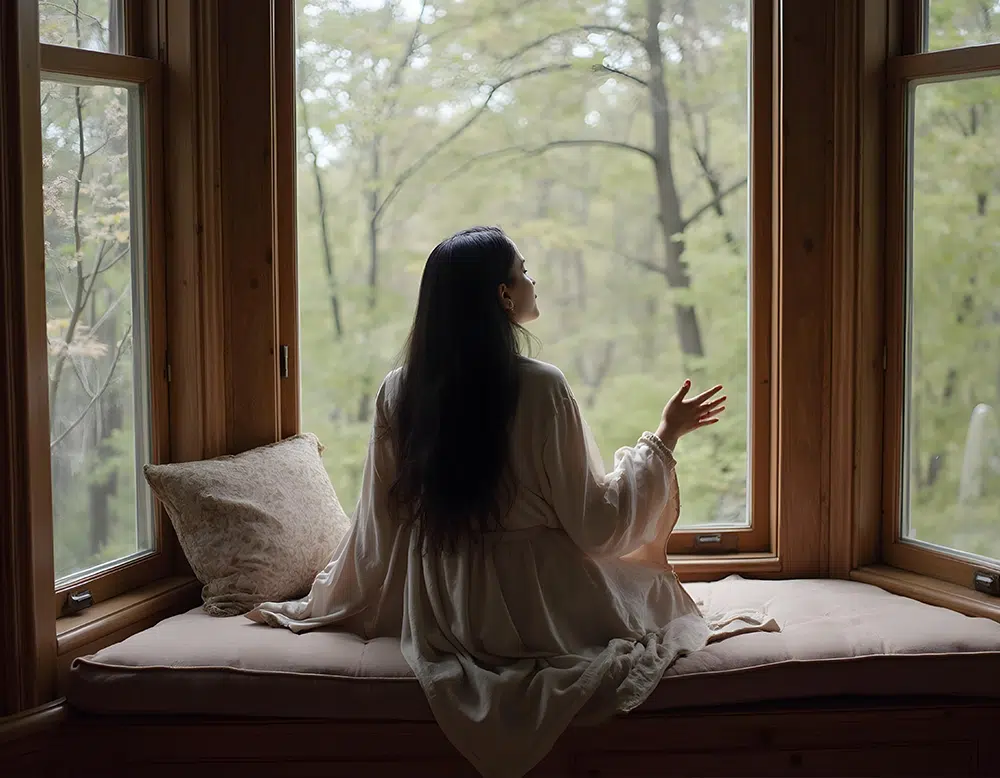Bay Windows Overview
Definition and Overview
A bay window is a unique architectural element that extends outward from a building’s exterior wall, creating a cozy nook or ledge inside. Typically made up of three or more window panels that form a curve or angle, they add both depth and dimension to a room.
Historical Background
The concept of bay windows dates back to the medieval period, where they were used to add space and light to castles and grand homes. Over the centuries, their design evolved, becoming a staple in Victorian and Edwardian architecture, where they were valued for their ability to create additional space while improving a building’s exterior.
Popularity and Common Uses
These windows are popular for their versatility, adding style to both the interior and exterior of a home. Commonly found in living rooms, bedrooms, and kitchens, they provide panoramic views, increase natural light, and create inviting spaces for seating or storage.
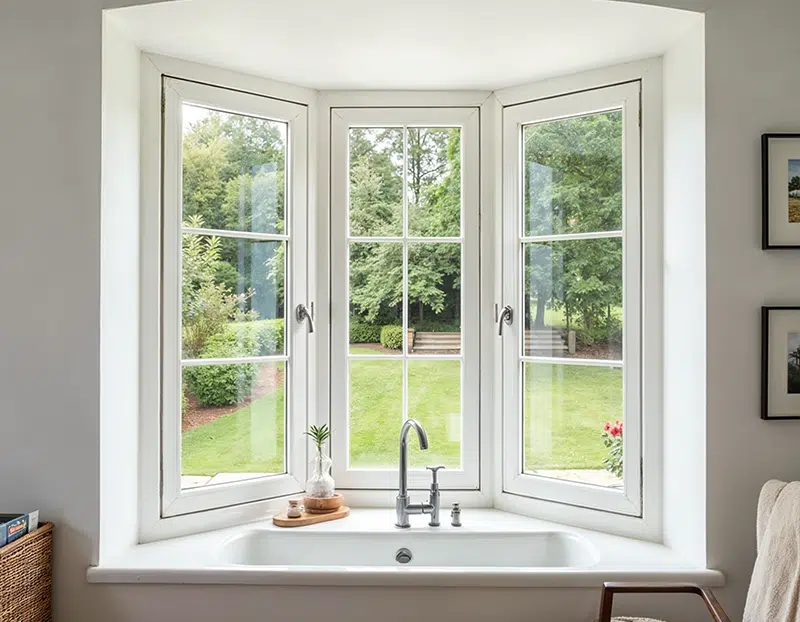
Types of Bay Windows
Canted Bay Window
Canted bay windows feature a flat front with angled sides that connect to the walls at a diagonal. The traditional style of this window is often seen in Victorian homes and is appreciated for its elegant, timeless appeal.
Box Bay Windows
Box bay windows have a rectangular shape, with sides meeting the front panel at a 90-degree angle. These windows are often used in kitchens to create a breakfast nook or in living rooms to add a cozy seating area.
Oriel Bay Window
Oriel bay windows are unique in that they do not extend to the ground but are instead supported by corbels or brackets. They are historically significant, particularly in Gothic and Tudor architecture, and are often found on the upper floors of buildings.
Circle Bay Window
Circle bay windows create a semi-circular or rounded shape, offering a distinctive design that adds ample natural light. Though less common, these windows are highly sought after for their unique aesthetic.
| Window Type | Description | Key Features |
| Canted Bay Window | Traditional bay window with a flat front and angled sides. | Timeless appeal, commonly found in Victorian homes. |
| Box Bay Window | Rectangular shape with sides meeting the front panel at a 90-degree angle. | Often used in kitchens for breakfast nooks or cozy seating areas. |
| Oriel Bay Window | Supported by corbels or brackets, does not extend to the ground. | Historically significant, commonly found on upper floors. |
| Circle Bay Window | Semi-circular or rounded shape, creating a distinctive nook inside. | Provides ample natural light, unique aesthetic. |

Design and Style Options
Frame Material Choices
- Wood
Wood frames offer a classic, warm appearance that can be stained or painted to match your decor. Regular maintenance, including painting or sealing, is required to prevent issues like rot or warping. - Vinyl
Vinyl is a low-maintenance, moisture-resistant option available in various colors. It’s cost-effective and can mimic wood, but it may not offer the same aesthetic appeal or durability in extreme temperatures. - Aluminum
Aluminum frames are strong, durable, and provide a modern look. While they are resistant to rust and can support larger panes of glass, they are less energy-efficient than other materials due to their high conductivity. - Fiberglass
Fiberglass combines strength with energy efficiency, resisting warping, rotting, and expanding. Though more expensive than vinyl, it offers superior durability and insulation, making it ideal for extreme climates.
Glass Types
- Double-Pane Glass
Double-pane glass consists of two layers with a sealed airspace between them, providing better insulation and reducing noise. Double-Pane Glass is standard for energy efficiency. - Low-E Glass
Low-E glass features a special coating that reflects heat while allowing light to pass through. The coating helps keep homes cooler in the summer and warmer in the winter. - Tinted Glass
Tinted glass reduces glare and heat from sunlight, making it ideal for rooms with strong sun exposure. It also offers some privacy during the day by limiting visibility from outside. - Decorative Glass
Decorative glass, such as frosted, stained, or textured glass, adds an artistic touch to your bay window. These options provide privacy while allowing natural light to enter and can be customized to match your home’s style.
Architectural Styles
Bay windows can complement various architectural designs, making them a versatile window style for improving both the aesthetic appeal and functionality of a home. In Victorian and Tudor homes, they add historical charm, while in modern styles, they create a striking central feature. Customization options, including shape, size, and the number of panels, allow bay windows to integrate seamlessly with almost any home design.
Customization and Finishes
Bay windows offer numerous customization opportunities, from frame materials and colors to decorative grilles and hardware. Finishes like wood stains, painted frames, and textured glass add personal touches, contributing to the overall aesthetic of the home.
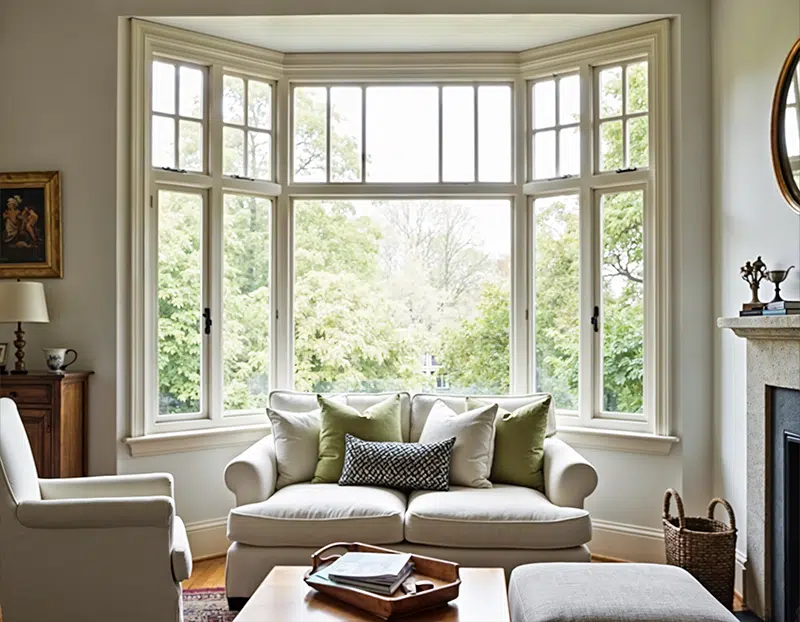
Functionality and Operation
Ventilation and Natural Light Benefits
Bay windows can increase airflow, especially when operable windows like casement or double-hung styles are included. Opening the side windows can create a cross-breeze, promoting fresh air circulation throughout the room.
Energy Efficiency
Bay windows, particularly those with double-pane or Low-E glass, offer excellent insulation, helping to reduce energy costs by maintaining indoor temperatures. They can reduce the need for artificial lighting during the day because of the natural light benefits they provide.
Operational Mechanisms
Various window types can be used in bay configurations, each with unique functionality. Casement windows, hinged at the side, maximize airflow, while double-hung windows offer a more traditional look by sliding up and down. Fixed panels, such as picture windows, can provide unobstructed views.
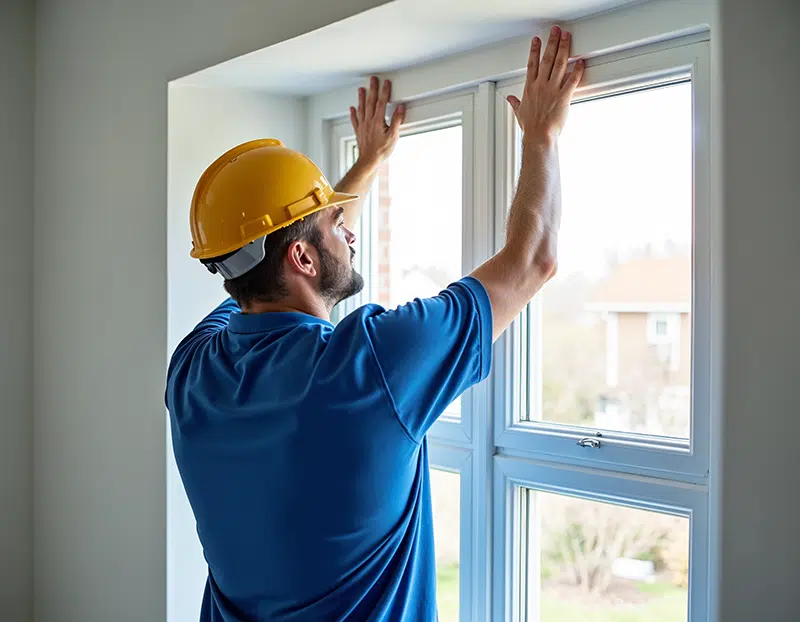
Installation Process
Installation Steps
- Preparing the Opening
Start by removing the existing window and verifying that the opening is the correct size and shape for the new bay window. Check for structural issues, such as rot or damage, before proceeding with the window installation. - Installing the Frame
Position the new bay window frame in the prepared opening, making sure it is level and square. Secure it to the wall, adding insulation around the frame to prevent drafts and lower energy consumption from your home’s HVAC. - Securing and Sealing
Finally, secure the window and seal any gaps. Caulk around the edges, install weatherstripping on operable windows, and make sure the window is properly supported to prevent sagging. Proper sealing prevents water infiltration and maintains long-term durability.
Professional vs. DIY Installation
While installing replacement windows, such as a bay window, on your own can be cost-effective, the process is complex and requires skill. Hiring a professional window company guarantees correct installation and complying with local building codes, and minimizes the risk of future issues.
Common Installation Challenges
Challenges include providing adequate support for the window’s weight, dealing with uneven walls, and achieving effective weatherproofing. A structural engineer may be required for larger installations, especially in older homes where the existing structure may not support the added load.

Maintenance and Care
Regular Cleaning Tips
- Frame Cleaning
Clean the frames regularly to maintain their appearance. For wood, use a soft cloth and a gentle cleaner designed for wood. Vinyl and aluminum frames can be wiped down with mild soap and water. Dry thoroughly to prevent moisture damage. - Glass Cleaning
Use a non-abrasive glass cleaner and a soft, lint-free cloth to clean the glass. Clean both inside and out for the best results. For stubborn spots, a mixture of vinegar and water works well. - Track and Hardware Cleaning
Clean the tracks and hardware of operable windows regularly. Use a soft brush or vacuum to remove dust and debris, and wipe down the hardware with a damp cloth. Lubricate moving parts with silicone spray to prevent sticking.
Inspections and Repairs
Regular inspections can help identify small common window problems before they escalate into major problems. Check for signs of wear or damage to the seals, glass, and frames.
- Seal Inspection
Regularly check the seals around your bay windows for cracks or gaps. Reseal the window with high-quality caulk if you notice any issues, maintaining its insulation properties. - Frame and Sill Inspection
Inspect the frames and sills for damage, such as rot, warping, or cracks. Pay special attention to where the window meets the wall. Repair or replace damaged sections promptly to prevent further deterioration. - Glass and Hardware Inspection
Check the glass panes for condensation between layers, which could indicate seal failure. Inspect the hardware, such as locks and hinges, to confirm they function properly. Replace any damaged hardware to keep your windows secure and operable.
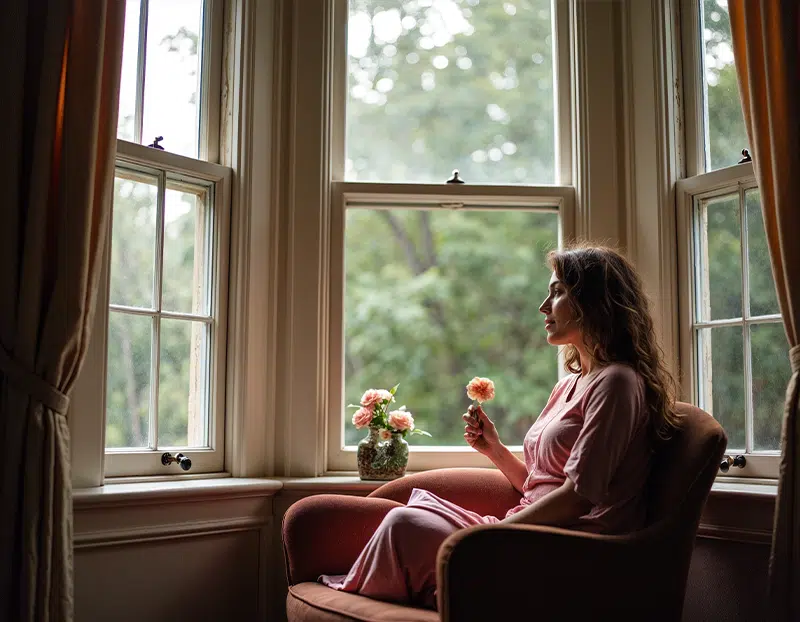
Pros and Cons of Bay Windows
Advantages
- Expanding Interior Space
Bay windows add interior space, ideal for seating, storage, or decoration, making rooms feel larger and more open. - Improving Natural Light
With multiple panels, bay windows allow more natural light, creating a bright, inviting atmosphere. - Boosting Home Value
Bay windows are a desirable feature, adding curb appeal and functionality, which can increase your home’s value. - Aesthetic Appeal
Bay windows improve the visual appeal of both the interior and exterior, making them a central feature in your home. - Adding a Window Seat
A built-in window seat adds to the functionality and aesthetic appeal of a bay window, providing a cozy spot for reading or relaxation.
Disadvantages
- Higher Costs
Bay windows are typically more expensive than standard windows, due to their complexity and custom sizing. - Potential Structural Concerns
Larger bay windows may require additional structural support, complicating installation and increasing costs. - Increased Maintenance Needs
Due to their size and materials, bay windows may require more maintenance, including regular cleaning and seal inspections.
| Advantages | Disadvantages |
| Expands interior space, ideal for seating, storage, or decoration. | Higher costs due to complexity and custom sizing. |
| Improves natural light, creating a bright, inviting atmosphere. | May require additional structural support, especially for larger windows. |
| Boosts home value by adding curb appeal and functionality. | Increased maintenance needs, particularly for larger windows and certain materials. |
| Enhances both the interior and exterior visual appeal of the home. | Complex installation process, often requiring professional help. |

Comparing Bay Windows to Other Window Types
Bay Window vs. Bow Window
Bay and bow windows are popular choices for homeowners looking to improve their home’s value and energy efficiency.
Although they share similarities, they differ in their structure and appearance. Bay windows have a more angular design, typically consisting of three panels that extend outward from the exterior walls. In contrast, bow windows feature a curved structure with four or more panels forming a gentle arc. This design gives bow windows a broader, more panoramic view and a softer, more rounded look compared to the sharper lines of bay windows.
Bay Window vs. Picture Window
Picture windows offer unobstructed views but do not open for ventilation. Bay windows combine views with operable side windows, allowing for air circulation.
Bay Window vs. Flat Window
Flat windows, like double-hung or casement windows, do not project outward. Bay windows create additional interior space, making them ideal for adding a cozy nook or extra seating.

Cost Considerations
Factors Influencing Cost
Several factors influence the overall cost of a bay window.
- Size and Design: Larger windows and more intricate designs generally cost more due to the additional materials and labour involved.
- Material and Glass Choices: The type of materials used for the frame and the glass can significantly impact the price, with options like wood or specialized glass adding to the cost.
- Installation Complexity: Installation costs vary depending on the complexity of the project and the window’s location, with more challenging installations requiring additional time and expertise.
Cost vs. Value
Bay windows may require a higher initial investment, but they can add significant value by improving the home’s appearance and functionality. The increase in home value and energy savings can offset the initial cost.
Budgeting Tips
When budgeting, consider both the window and installation costs. Prioritize quality materials and professional installation to promote long-lasting performance.

Choosing the Right Bay Window for Your Home
Assessing Your Needs
Identify the purpose of the bay window in your home, whether it’s increasing natural light, creating additional seating, or improving a specific view.
Climate and Environmental Considerations
Local climate plays a significant role in material and design choices. Energy-efficient glass and insulated frames are very important in colder climates, while tinted glass may be better for warmer areas.
Matching with Home Design
Bay windows should complement your home’s architectural style. Whether traditional or modern, choosing a bay window that matches your home’s design improves its overall appearance and appeal.
| Customer Need | Recommended Material | Recommended Glass Type | Recommended Window Type |
| Maximizing Natural Light | Aluminum | Low-E Glass | Bow Window |
| Creating a Cozy Seating Area | Wood | Double-Pane Glass | Box Bay Window |
| Enhancing Energy Efficiency | Fiberglass | Low-E Glass | Canted Bay Window |
| Adding Architectural Interest | Vinyl | Decorative Glass | Oriel Bay Window |
Common Myths and Misconceptions
It’s Hard to Maintain a Bay Window
With regular cleaning and maintenance, bay windows can be as easy to maintain as any other window. Advances in materials and glass technology have made them more user-friendly.
Bay Windows Are Too Expensive
While more costly than flat windows, bay windows offer significant benefits, including improved appearance and added space, making them a worthwhile investment.
Only Old Homes Use Bay Windows
Bay windows are often associated with older homes, but they can be a beautiful addition to modern designs as well. With various styles, materials, and customization options, bay windows can fit virtually any home.
Upgrade Your Home with Bay Windows!
Interior Design Ideas
The bay window creates perfect spaces for a reading nook, seating area, or bright spot for plants. Adding accent chairs, cushions, and window treatments can turn the bay window into a room’s central feature.
Landscaping and Exterior
A bay window can enhance your home’s exterior. Incorporating landscaping elements like flower boxes or trellises, and matching the bay window with the house’s overall design can boost curb appeal.
Contact us today to discuss your interest in new bay windows for your home. We can answer any questions you have about bay windows, and give you advice based on your home’s unique layout. We can also offer you a quote for any window installation you require!


